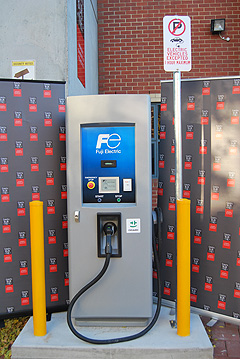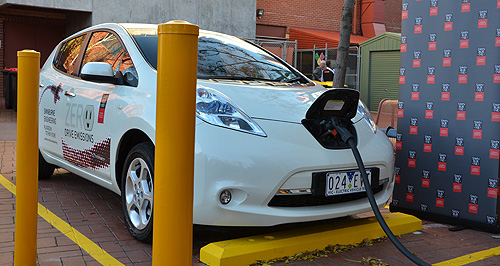Make / Model Search
News - General News - Electric VehiclesSwinburne switches on EV charge stationCharge your glasses: From left, ChargePoint CEO James Brown, transport minister Terry Mulder and Swinburne vice-chancellor Professor Linda Kristjanson. Melbourne charging station takes 30 minutes to charge EV5 Jul 2013 SWINBURNE University is home to Victoria’s first ‘fast’ electric vehicle charging station – a public facility that charges your EV in a claimed 30 minutes. The new station at Swinburne’s Hawthorn campus therefore reduces the time for a full charge compared to a regular household outlet, which customarily taken between eight to and 10 hours. The station is co-funded by Swinburne University and the Victorian government’s $5 million Electrical Vehicle Trial, which aims to make Victoria a more EV-friendly state by increasing the number of public charging stations and improving awareness of EVs. Swinburne’s faculty of engineering and industrial science paid for installation, while the Victorian government kicked in $38,000 of taxpayer money. Swinburne vice-chancellor, Professor Linda Kristjanson, praised the university’s Electric Vehicle Research Group for its local contribution to research and development of EVs. “Having this fast charging facility on campus, as part of the Victorian Government's Electric Vehicle Trial, will benefit the research which is currently underway at Swinburne into creating greener transport options for the future,” she said.  Left: Fast charging station at Swinburne University, Melbourne. Left: Fast charging station at Swinburne University, Melbourne.The faculty is currently leasing a Nissan Leaf EV to provide feedback on the station, while Swinburne researchers will collect data from the charging station for research purposes. The charging station was supplied and installed by ChargePoint, which has installed a number of charging stations in different locations across Australia. ChargePoint’s fast-charging station uses direct current (DC) charging direct to the battery, as opposed to a regular charger, or level two charger, that uses alternate current (AC) which is slower but demands less energy from the grid. Swinburne’s station will be accessible to any member of the public that has signed up to ChargePoint, 24 hours a day, from William Street at the rear of its Hawthorn campus. EV drivers can get access to the station by swiping a ChargePoint card, via a smart-phone app or by contacting the call centre and going through a verification process. Currently, there is no cost to use the fast charge station at Swinburne, but ChargePoint CEO James Brown said there is a chance Swinburne could start charging for use down the track, in which case users can pay by credit card. Mr Brown said there were plans for more fast chargers beyond the eight stations currently in use around Australia, including the new station at Swinburne and existing stations at Mitsubishi’s head office in Adelaide and NRMA HQ in Sydney. Fast chargers are limited to pure electric vehicles such as the Mitsubishi i-MiEV and Nissan Leaf, meaning plug-in hybrids such as the Holden Volt must use slower level two chargers. Mr Brown said the Swinburne fast charger won’t be the last station to roll out in Melbourne, but also said not to expect a rapid expansion just yet. “The fast chargers will continue to roll out but they will be done in a very strategic and considered way because you have got to look at the logistics of EV transport,” he said. The benefit of EV transport is that you can refuel when you are parking it, for long times. “Cars spend most of their time sitting there doing nothing anyway. The charging regime should be really aligned to where people are parking so you use the time to recharge it when the car is not doing anything.” Mr Brown said the cost of installing new charging stations will also ensure a slow roll out across the country. “Will they proliferate? They will, but given the investment cost and impact on grid and various other things, they will be placed in very strategic locations. “We are looking at where you can judiciously put one in but you have to balance that with the capital cost with them as well, it’s not exactly cheap.” One issue in setting up public stations is maintaining the parking space as an EV-only space and discouraging drivers of internal combustion engined cars from using them. Mr Brown said ChargePoint had received feedback from charge station users in Sydney complaining about the issue, which prompted the council to employ a similar strategy to the one used for parking spaces dedicated to car-share scheme vehicles. “We had that problem occurring quite a lot at a charging station at Rouse Hill in Sydney. For some reason, even though we are only with the operator not the owner, we were getting very irate phone calls from drivers saying ‘there is a car parked in the spot, I can’t recharge.’ “They (the council) painted it green and made it into a very distinct EV parking space. You are never going to stop people parking there when they get excited or irate about getting a park at Christmas time, but when you start painting it, the majority of people do respect that it is a specified spot for a specified reason,” he said. A number of Nissan and Mitsubishi dealers across Australia have level two charging stations available with 24 hour-access for their Leaf and i-MiEV customers, while many companies have charging stations at their corporate headquarters.  Read more4th of December 2012  GoGet joins EV TrialVictorian government extends EV trial to include car-share operator4th of December 2012  EV range deemed acceptableVictorian trial shows electric-car drivers are comfortable with range, but not price |
Click to shareGeneral News articlesResearch General News Motor industry news |











Facebook Twitter Instagram